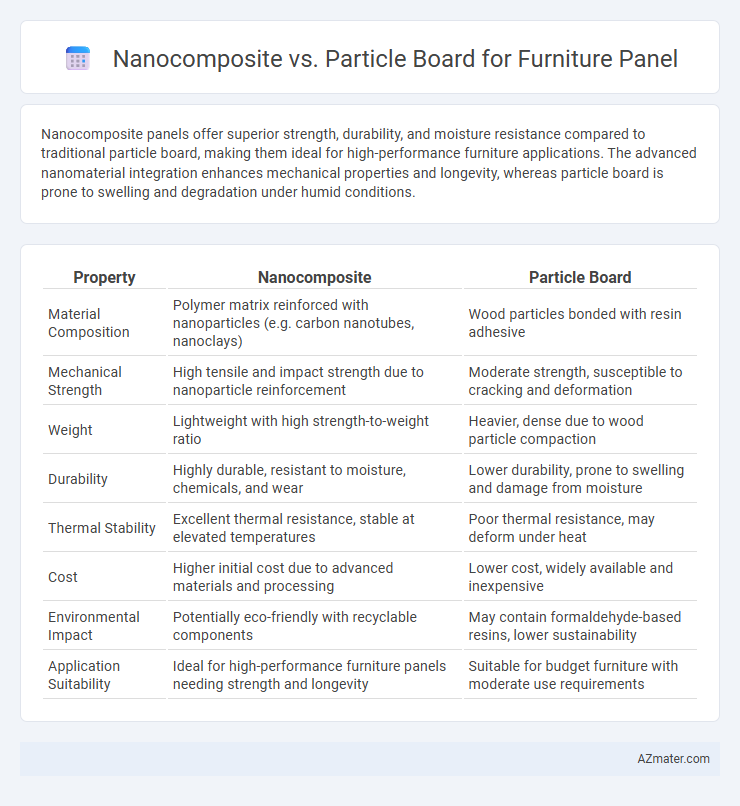Nanocomposite panels offer superior strength, durability, and moisture resistance compared to traditional particle board, making them ideal for high-performance furniture applications. The advanced nanomaterial integration enhances mechanical properties and longevity, whereas particle board is prone to swelling and degradation under humid conditions.
Table of Comparison
| Property | Nanocomposite | Particle Board |
|---|---|---|
| Material Composition | Polymer matrix reinforced with nanoparticles (e.g. carbon nanotubes, nanoclays) | Wood particles bonded with resin adhesive |
| Mechanical Strength | High tensile and impact strength due to nanoparticle reinforcement | Moderate strength, susceptible to cracking and deformation |
| Weight | Lightweight with high strength-to-weight ratio | Heavier, dense due to wood particle compaction |
| Durability | Highly durable, resistant to moisture, chemicals, and wear | Lower durability, prone to swelling and damage from moisture |
| Thermal Stability | Excellent thermal resistance, stable at elevated temperatures | Poor thermal resistance, may deform under heat |
| Cost | Higher initial cost due to advanced materials and processing | Lower cost, widely available and inexpensive |
| Environmental Impact | Potentially eco-friendly with recyclable components | May contain formaldehyde-based resins, lower sustainability |
| Application Suitability | Ideal for high-performance furniture panels needing strength and longevity | Suitable for budget furniture with moderate use requirements |
Introduction to Nanocomposite and Particle Board
Nanocomposites are advanced materials composed of a polymer matrix embedded with nanoparticles, offering enhanced mechanical strength, thermal stability, and resistance to moisture compared to conventional materials. Particle boards, made from wood particles bonded with resin under heat and pressure, are widely used in furniture for their affordability and ease of manufacture but often suffer from lower durability and susceptibility to water damage. The integration of nanocomposites in furniture panels presents a cutting-edge alternative, improving panel performance while maintaining lightweight characteristics.
Composition and Material Science
Nanocomposites in furniture panels comprise a polymer matrix embedded with nanoscale fillers such as clay, carbon nanotubes, or silica, enhancing mechanical strength, thermal stability, and moisture resistance due to improved interfacial bonding and nanoscale dispersion. Particle board consists primarily of wood particles or fibers bonded with synthetic resins like urea-formaldehyde, exhibiting lower density and structural integrity compared to nanocomposites, which offer superior dimensional stability and durability. Material science advances highlight that nanocomposites' tailored nanoscale inclusions drastically improve performance metrics like tensile strength and resistance to wear, distinguishing them from conventional particle board panels.
Manufacturing Processes
Nanocomposite panels incorporate nanoparticles such as nanoclays or carbon nanotubes into polymer matrices through processes like solution blending, in-situ polymerization, or melt compounding, resulting in enhanced mechanical and thermal properties. Particle board manufacturing involves wood particles mixed with synthetic resin adhesives, followed by hot pressing to form dense, uniform panels commonly using urea-formaldehyde or phenol-formaldehyde resins. The precision and complexity of nanocomposite fabrication generally require advanced equipment and controlled environments, while particle board production relies on established industrial-scale processes with cost efficiency and scalable volumes.
Mechanical Strength Comparison
Nanocomposite panels exhibit superior mechanical strength compared to traditional particle boards due to the incorporation of nanoparticles that enhance load distribution and resistance to deformation. The nanoscale reinforcements improve tensile, flexural, and impact properties, resulting in higher durability and structural integrity for furniture applications. In contrast, particle boards, composed mainly of wood chips and resins, tend to have lower mechanical strength and are more susceptible to moisture-induced weakening and surface wear.
Durability and Lifespan
Nanocomposite panels exhibit superior durability and extended lifespan compared to traditional particle boards due to their enhanced mechanical strength and resistance to moisture and wear. The integration of nanoparticles in nanocomposites improves structural integrity, reducing susceptibility to warping, cracking, and degradation over time. Particle boards tend to absorb moisture easily, leading to swelling and reduced durability, making nanocomposites a more reliable choice for long-lasting furniture panels.
Environmental Impact and Sustainability
Nanocomposite panels exhibit superior environmental benefits over traditional particle boards due to their enhanced durability and reduced material consumption, which lowers overall resource depletion. The use of nanomaterials in nanocomposites allows for extended furniture lifespan and improved recyclability, thereby decreasing landfill waste and carbon footprint associated with production and disposal. In contrast, particle boards often rely on formaldehyde-based adhesives and virgin wood fibers, contributing to higher emissions and less sustainable forestry practices.
Cost Analysis and Affordability
Nanocomposite panels often have higher upfront costs compared to traditional particle boards due to advanced materials and manufacturing processes. However, their superior durability and resistance to moisture and wear can reduce maintenance and replacement expenses over time. Particle boards provide a budget-friendly option for furniture panels, appealing to cost-sensitive projects despite shorter lifespan and susceptibility to damage.
Applications in Furniture Design
Nanocomposites offer enhanced mechanical strength, thermal stability, and moisture resistance compared to traditional particle boards, making them ideal for high-performance furniture panels in modern design. Particle boards remain popular for cost-effective, lightweight furniture solutions, especially in budget-conscious or temporary applications where structural demands are moderate. Integrating nanocomposites allows designers to create durable, aesthetically versatile panels suitable for both indoor and outdoor furniture, supporting innovative and sustainable design trends.
Aesthetic Qualities and Finishing Options
Nanocomposite panels offer superior aesthetic qualities compared to traditional particle boards, featuring a smoother surface and enhanced color retention due to their nano-enhanced resin matrix. The advanced finishing options available for nanocomposites include high-gloss, matte, and textured finishes that resist scratches and fading, providing long-lasting visual appeal. Particle boards, while cost-effective, typically require additional laminates or veneers to achieve similar aesthetic results but lack the durability and uniform finish of nanocomposites.
Which is Better for Furniture Panels?
Nanocomposite panels outperform particle boards in furniture applications due to their superior mechanical strength, enhanced durability, and resistance to moisture and termite damage. The integration of nanomaterials in composite panels improves stiffness and impact resistance, making them ideal for high-load furniture components. Particle boards, while cost-effective, typically lack the longevity and structural integrity required for premium or long-lasting furniture panels.

Infographic: Nanocomposite vs Particle Board for Furniture Panel
 azmater.com
azmater.com